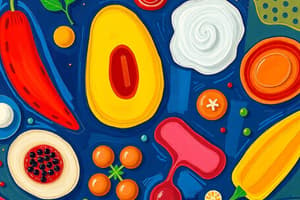Podcast
Questions and Answers
What structural component do lipids consist of?
What structural component do lipids consist of?
- A molecule of glycerol and three fatty acids (correct)
- Multiple chains of sugars
- A molecule of glucose and two fatty acids
- A single chain of amino acids
Which of the following is NOT a function of proteins?
Which of the following is NOT a function of proteins?
- Growth and repair of tissues
- Enzymes
- Energy storage (correct)
- Structural support
Which mineral is primarily associated with the formation of hemoglobin in red blood cells?
Which mineral is primarily associated with the formation of hemoglobin in red blood cells?
- Iron (correct)
- Magnesium
- Calcium
- Sodium
What is a common symptom of Kwashiorkor?
What is a common symptom of Kwashiorkor?
Which food is NOT a recommended source of lipids?
Which food is NOT a recommended source of lipids?
How many essential amino acids must humans consume?
How many essential amino acids must humans consume?
Which of the following is a health concern associated with cholesterol?
Which of the following is a health concern associated with cholesterol?
Which mineral is known for its role in muscle function and is found in green vegetables?
Which mineral is known for its role in muscle function and is found in green vegetables?
Flashcards
Lipids
Lipids
Organic compounds made of glycerol and fatty acids, used for energy storage, insulation, and organ protection.
Protein Function
Protein Function
Proteins have diverse roles, including forming enzymes, providing structural support, and many other essential processes.
Essential Minerals
Essential Minerals
Minerals like calcium, iron, and phosphorus are crucial for body functions, like bone formation and oxygen transport.
Cholesterol: Function
Cholesterol: Function
Signup and view all the flashcards
High Cholesterol: Risk?
High Cholesterol: Risk?
Signup and view all the flashcards
Kwashiorkor
Kwashiorkor
Signup and view all the flashcards
Essential Amino Acids
Essential Amino Acids
Signup and view all the flashcards
Protein in Vegetarian Diet
Protein in Vegetarian Diet
Signup and view all the flashcards
Study Notes
Food and Digestion
- Lipids are fats, either solid or liquid at room temperature
- Plant lipids are usually liquid and called oils
- Animal lipids are usually solid and called fats
- Lipids are made of glycerol and fatty acids
- Lipids store energy, insulate the body, and protect organs
Lipids
- Lipids make up about 10% of the body's mass
- Lipids are a long-term energy store
- Fat acts as insulation, reducing heat loss
- Fat around organs protects them from damage
- Saturated fats are more common in animal products
- Unsaturated fats are more common in plant oils
- Saturated fats are less healthy than unsaturated fats
Proteins
- Proteins are polymers made of amino acids
- Proteins are essential for growth and repair
- Proteins can be enzymes or structural components
- Proteins are about 18% of the body's mass
- Protein deficiency can lead to kwashiorkor
- Recommended daily protein intake is about 70g
- Essential amino acids must be obtained from food
Minerals
- Minerals are chemical elements needed by the body
- Minerals are in our food as mineral ions
- Minerals are used for a variety of bodily functions, including bone growth
- Minerals required by the body in large amounts include calcium and phosphorus
- Minerals required by the body in smaller amounts include sodium, chlorine, magnesium, and iron
- Calcium and phosphorus build teeth and bones
- Sodium and Chlorine are found in body fluids
- Magnesium makes bones and is part of cells
- Iron is part of haemoglobin, carrying oxygen
Essential Amino Acids
- 10 amino acids are essential amino acids
- Essential amino acids must be obtained from food
- Meat, fish, eggs, and dairy products have high amounts of essential amino acids
- Vegetarians can obtain essential amino acids from plant products
Studying That Suits You
Use AI to generate personalized quizzes and flashcards to suit your learning preferences.




